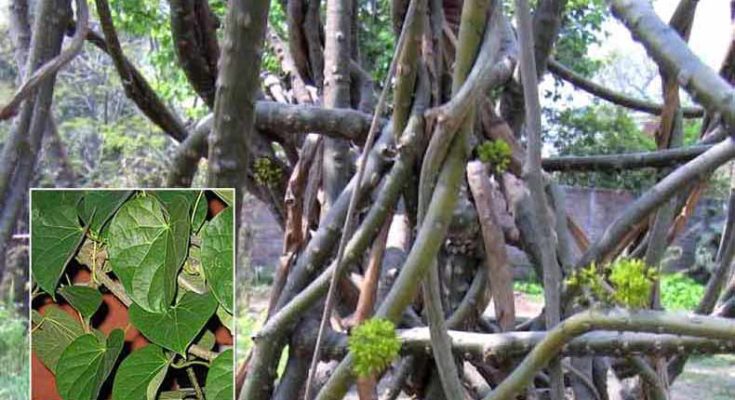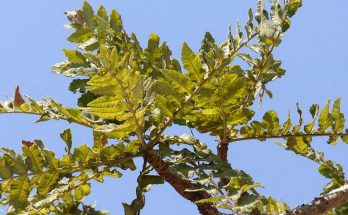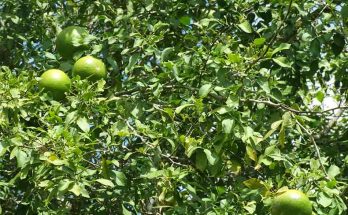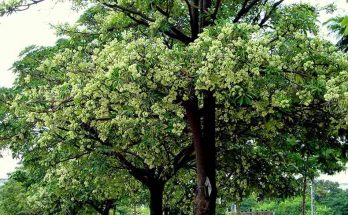Giloy conveys calming and antipyretic properties. It is useful to build an immune system to fight against virus and bacteria. Image Courtesy – http://toddcaldecott.com & http://www.absarmohamed.com.
Giloy or, Gulancha Tinospora is an expansive climber with succulent, corky, grooved stems with the branches sending down slim pendulous meaty roots. The leaves are membranous, 7-9 nerved, 5-12 cm. long, rounded or cordate which is heart-shaped. Male blooms are bunched in the axils and the yellow female blossoms are normally solitary. The natural products are pea-sized and red in shading when ready. It has various names like ‘Ambervel’, ‘Amrita’, ‘Gilo’, ‘Giloy’, ‘Giloya’, ‘Glunchanb’, ‘Guduchi’, ‘Gulvel’, ‘Gurcha’, ‘Heavenly Elixir’, ‘Indian Tinospora’, ‘Jetwatika’, ‘Moonseed’, ‘T. Cordifolia’, ‘Tinospora Indien’, ‘Tinosporia Cordifolus’.
This herb is a woody domestic plant of India. Roots, Stems, Leaves, Fruits are used in Ayurvedic Medicine. Tinospora Cordifolia contains different chemicals which help to protect our body from various diseases. Some of these chemicals have antioxidant effects. Others increase the immune system of our body. Some chemicals might have activity against cancer cells in test animals. Most research has been done in test tubes or on animals.
Giloy is a commonly utilized herb as a part of Ayurvedic frameworks of medication. The chemical compounds observed from this herb have a place with distinctive classes – ‘Alkaloids’, ‘Diterpenoid Lactones’, ‘Glycosides’, ‘Steroids’, ‘Sesquiterpenoid’, ‘Phenolics’, ‘Aliphatic compounds’, ‘Polysaccharides’ etc. The significant therapeutic properties observed are ‘Anti-allergic’, ‘Anti-stress’, ‘Anti-leprotic’, ‘Anti-malarial’, ‘Anti-diabetic’, ‘Anti-periodic’, ‘Anti-spasmodic’, ‘Anti-inflammatory’, ‘Anti-arthritic’, ‘Anti-oxidant’, ‘Hepatoprotective’, ‘Immunomodulatory’, ‘Anti-neoplastic activities’, etc.
Studies have shown that leaves of Giloy are rich in Protein (11.2%) and are fairly rich in Calcium and Phosphorus.
The stem of Giloy is one of the constituents of a few ayurvedic arrangements utilized in ‘Dyspepsia’, ‘Fever’, and ‘Urinary sicknesses’. The extract of its stem is effective in skin sicknesses. The root and stem of Giloy are all that successful in a mix with different medications as an antidote to snakebite and scorpion sting. Dry barks of Giloy has ‘Anti-spasmodic’, ‘Antipyretic’, ‘Anti-allergic’, ‘Anti-inflammatory’ and ‘Anti-leprotic’ properties.
Giloy is generally utilized as a part of the Indian Ayurvedic solution for treating diabetes mellitus. Oral management of the Giloy root extract to alloxan diabetic rats brought on a noteworthy decrease in blood glucose and cerebrum lipids. In spite of the fact that the fluid separation at a measurement of 400 mg/kg could evoke an ‘anti-hyperglycemic’ impact in different creature models, its impact was identical to only one unit/kg of insulin.
It is observed that the daily management of Giloy extract diminishes the blood glucose level and increments ‘glucose tolerance’ in rodents. Aqueous extract of Giloy likewise brought on a decrease in glucose in alloxan-induced hyperglycemia in rats and rabbits in the dosage of 400 mg/kg. Although histological examination of the pancreas has not disclosed any confirmation of recovery of the Beta-cells of islets of Langerhans – the conceivable method of activity of the plant is through the glucose digestion system.
The extract of Giloy has likewise displayed some inhibitory impact on ‘adrenaline-induced’ hyperglycemia. Ethyl acetic acid extract of the roots of this herb has managed a ‘Pyrrolidine derivative’ with hypoglycemic action in rabbits. Another study has likewise uncovered the noteworthy hypoglycemic impact of a concentrate of leaves in ordinary and alloxan-induced rabbits.
Read: Ashwagandha, the tremendous anti-ageing component
Disorders of Immunity:
Giloy conveys calming and antipyretic properties. This herb has been utilized as a part of ‘Ayurvedic Chemicals’ for hundreds of years that were extremely useful in building up the insusceptible framework and the body’s fight against viruses and bacterias. In an experimental study led utilizing human White Blood Corpuscles – the Ayurvedic herb helped in expanding the ‘killing capacity of macrophages’, the safe cells that are responsible for battling with microorganisms.
Stomach Ulcer:
Giloy is used for reducing pain in aggravated and injured mucous layers in the digestive tract. This herb ensures the stomach and duodenum by expanding the generation of ‘Mucin’. It is a substance that secures the coating of these organs against stomach acid and other destructive substances.
Urinary Problem:
The juice of the roots is all that useful in Urinary problems.
Mental Disorder:
The entire plant and juice of the leaves are generally utilized as a part of different mental disorders. This is viewed as one of the best psychotropic medications in India.
Caution:
Tinospora cordifolia is said to decrease the level of blood glucose. Diabetes drugs are additionally used to lower glucose. Bringing Tinospora cordifolia alongside diabetes prescriptions might bring about your glucose level to go too low. Monitor your glucose closely. The measurements of your diabetes prescription should be changed accordingly.
The Ayurveda literature reports that Giloy can bring about ‘constipation’ if taken frequently in high measurements; it has no reaction and poisonous quality. Yet, the security and the potential signs in individuals must be set up in utilizing modern medical systems.
Reference: Indian Journal of Pharmacology 2003 – Chemistry and Medicinal Properties of Tinospora Cordifolia (Giloy).





